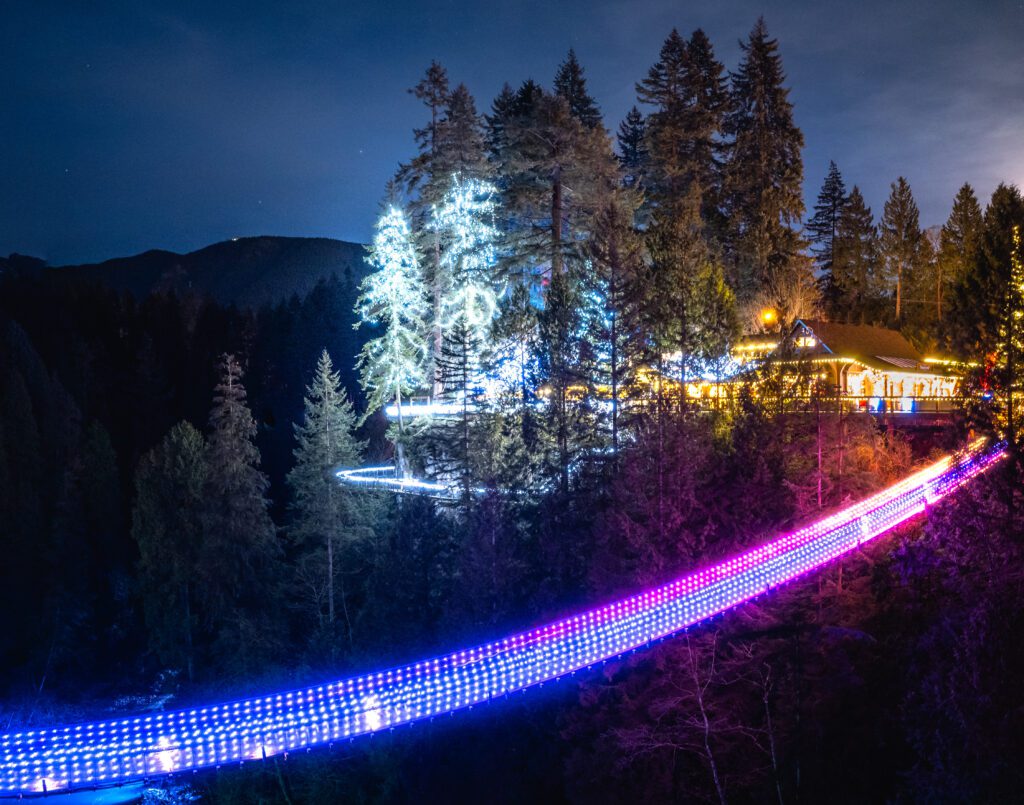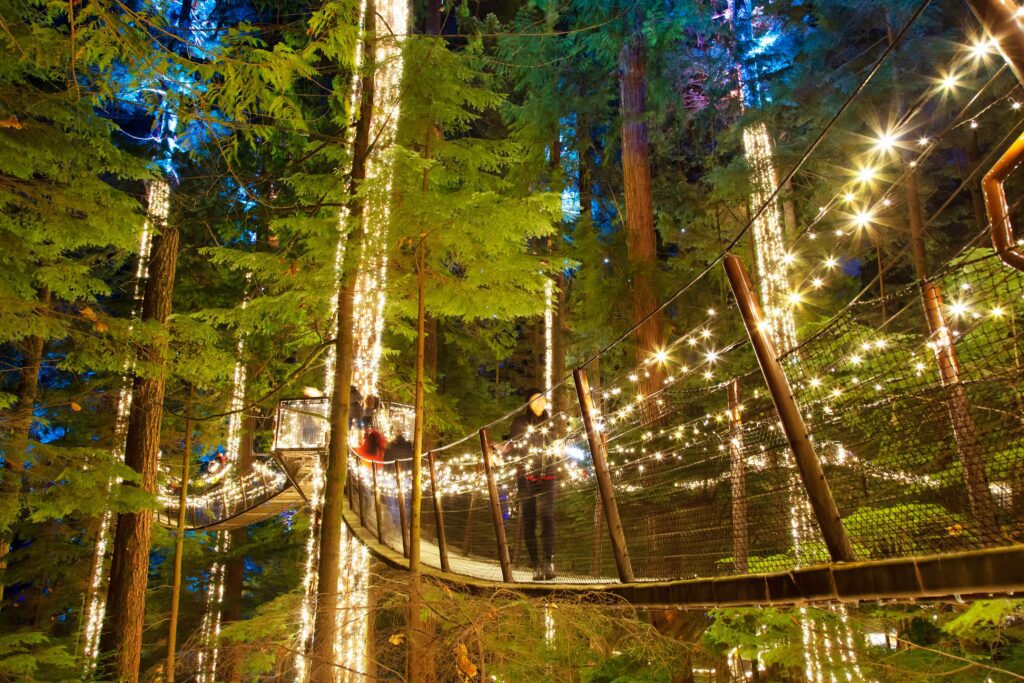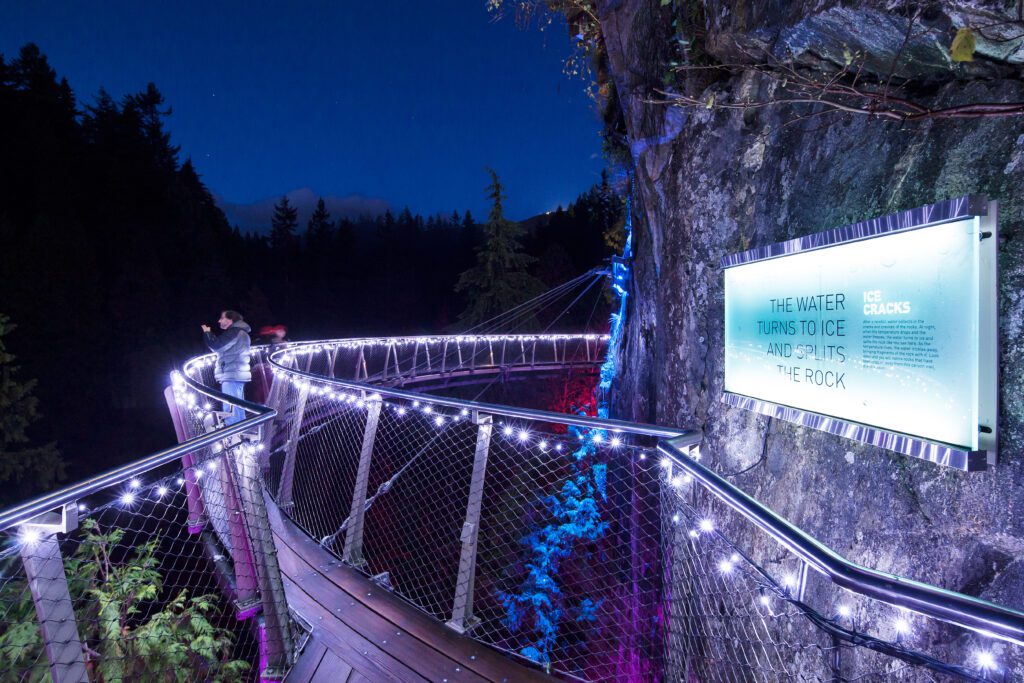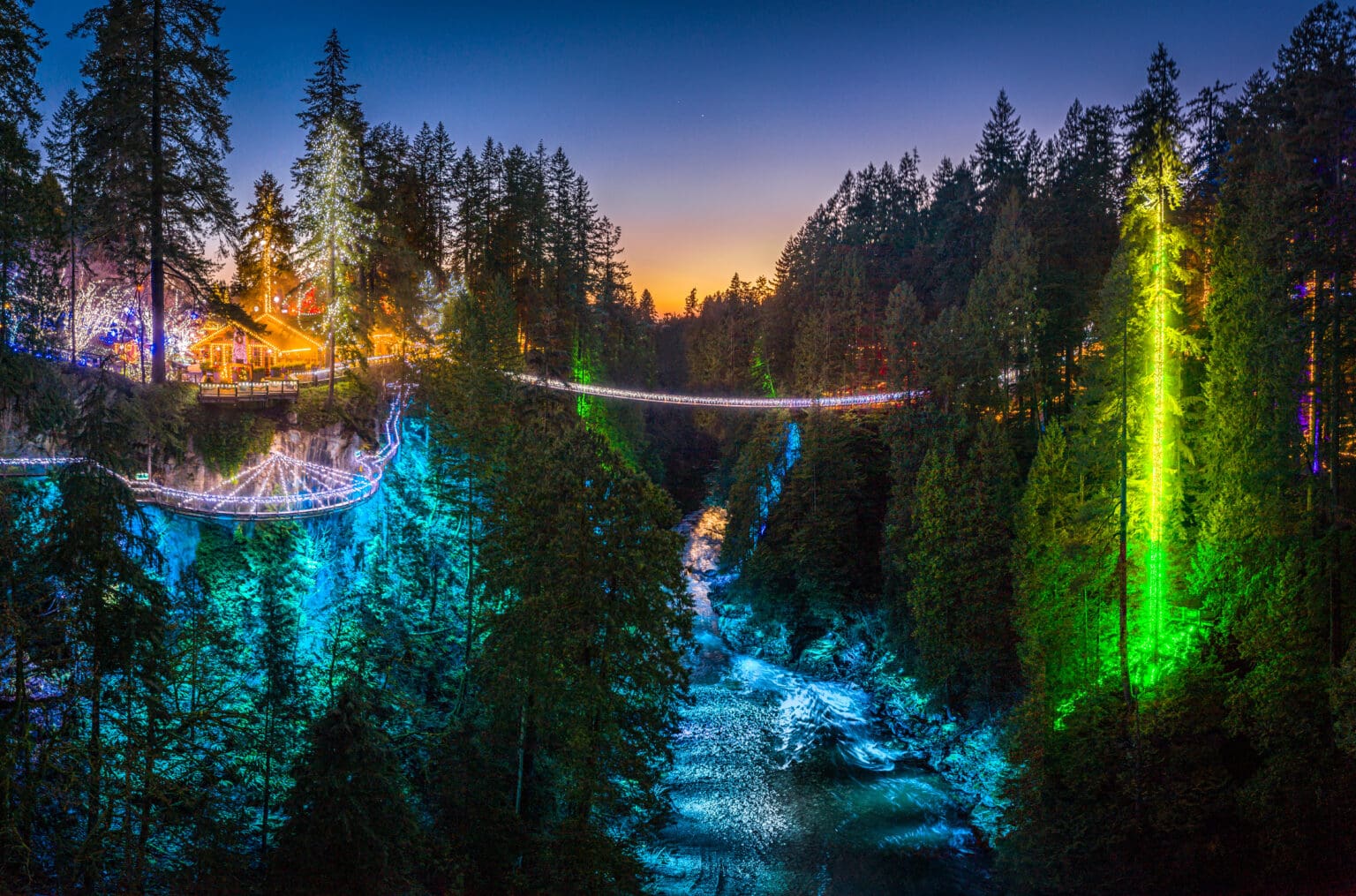NORTH VANCOUVER, B.C. – Forecasters promised rain, which seemed appropriate for a December outing in a temperate rainforest. Nothing personifies the Pacific Northwest quite like the wrath of a winter storm.
At least that’s what the old-timers say. In this case, the weather gods, like the Weather Channel, failed us.
My Seattle friend Kristi and I experienced a dry, mild afternoon at the privately owned Capilano Suspension Bridge Park, one of Vancouver’s last standing old-growth forests after decades of heedless clear-cutting of Cascadia.
“The forest is everything to us,” park spokeswoman Stacy Chala said. “We like to position ourselves as a little piece of British Columbia. You can get a full idea of what our coastal temperate rainforests are all about.”
About 150 years ago, ancient forests covered Vancouver and its surroundings with a complex landscape from the North Shore mountaintops to the U.S. border. Loggers mowed down most of the old trees in the early 1900s as Vancouver began its growth spurt.
From the vantage point of what was lost, the 27-acre Capilano park is a precious island that owners rescued from the ax. The old trees almost certainly would have been felled if the 230-foot-high suspension bridge had not become a roadside attraction.

Owners throughout the years could have sold the acreage to property developers, like some of the lower reaches of Grouse Mountain.
For now, some argue the preserve that attracts a million annual visitors is an opportunity to inspire stewardship of quickly diminishing natural resources.
I hope so, considering the swath of plowed mountainsides across the Pacific Northwest. If we’re not careful, tree museums like this are all we will have left of old forest ecosystems.
I called Ira Sutherland, author of the blog Vancouver Big Tree Hiking Guide, who embraces the duality of perspectives that intersect at the Capilano tourist site.
“Somebody can visit a place like Capilano and maybe it will turn on a lightbulb inside them, and it will be really meaningful,” said Sutherland, a forestry expert doing post-doctoral work at Simon Fraser University. “Others will feel cheated and disgruntled about the tokenism of it.”
I concede Capilano park offers an attractive family setting with its folksy Main Street Disneyland ethic. A visitor almost expects to find a blue-skinned humanoid from “Avatar” hiding in the lush canopy.
The park has one mile of pathways that offer a glimpse of what once was. With the skywalks, visitors see tall trees from new angles in one of the highlights beyond the swaying suspension bridge.

The park also showcases First Nations culture, starting with the name Capilano. It comes from the Squamish Nation’s Kia’palano, meaning “beautiful river.” Over the years, owners have hired Indigenous carvers to make totem poles featured in a display about First Nations heritage.
Interestingly, the 450-foot-long span did not start as a tourist attraction, Chala said.
In 1888, George Grant Mackay began building the structure from hemp rope and cedar planks to connect his property across a steep-walled canyon.
The bridge immediately attracted curiosity seekers. Mackay did not appreciate the trespassers and sold the property in 1892.
New owner Bruno Stelzer saw profit instead of nuisance with so much interest in a towering bridge. In 1903, he added wire cables and charged visitors 10 cents to walk across it.
The bridge had a succession of owners and updates. It got a major facelift in 1953 when then-owner Rae Mitchell reinforced the span with steel cable and concrete.
Mitchell sold the park in 1983 to enterprising daughter Nancy Stibbard. She reimagined the locale as a theme park with dining and a retail gift shop.
Stibbard also introduced popular events like Canyon Lights, which helped more than double visitation.
“It’s a fantastic example where somebody had a different vision for the forest and had the foresight to be an entrepreneur,” Sutherland said. “It turned out to be a really important place – a cultural sense of place – and it’s good for the ecosystem too.”
We visited recently during the 14th year running of the Canyon Lights show, which recently ended on Sunday, Jan. 21. Park managers drape the bridge, the walkways and some of the trees with 1 million glittering lights.
Another lighting event is scheduled for Feb. 2-25: Love Lights, described as a love song of magical illuminated displays.
Thankfully, the sun didn’t press through the cloud cover and thick rainforest canopy to mute the lights during our early afternoon visit.
We knew they weren’t as vivid as after sunset. But I’m happiest in a tumbled old forest without artificial additives.
Next time, I’ll avoid the expensive tourist attraction to explore the rest of Grouse Mountain.
Nearby trails offer less-crowded options without charging admission. That includes a 164-foot-high suspension bridge in Lynn Canyon Park shown in the Netflix series, “Virgin River.” “X-Files” filmed forest scenes at Lower Seymour Conservation Reserve.

Another good alternative is the Capilano Pacific Trail, about nine miles roundtrip from the Burrard Inlet to Cleveland Dam. Impressive Douglas firs like the Grandpa Capilano are found on the Giant fir trail. Loggers probably left them because they were too old and gnarled to extract, Sutherland has written.
In September, Kristi and I spent a week on the west coast of Vancouver Island wandering through the supreme rainforests of Pacific Rim National Park Reserve on the traditional land of the Nuu-chah-nulth people.
Streaks of sunlight filtered through thick groves of Sitka spruce, western hemlocks and western red cedars. The naturally adorned forest felt fresh. It felt real.
I understand the attraction to colorful winter lights and hot cocoa. It creates a festive atmosphere.
It’s just not for me. Perhaps a few raindrops might have helped create a wintery mood.
If You Go
Where: 3735 Capilano Road, North Vancouver, British Columbia.
What: A 27-acre private park with a famous suspension bridge and paths through an old-growth temperate rainforest.
Operation: Open year-round except for Dec. 25. Check the website for varying hours of operation.
Tickets: Prices vary depending on the seasons. Tickets can be purchased online.
Parking: $6 for three hours on site.
Shuttle: A free shuttle service runs every half hour from Canada Place at Howe and Burrard streets in downtown Vancouver.
Public Transit: Take the SeaBus or Skytrain. For schedules and routes, check the TransLink website.
Time from Bellingham: About 1 hour, 15 minutes, depending on the border crossing.
Elliott Almond’s outdoor column appears monthly. Email: elliottalmond4@gmail.com.





